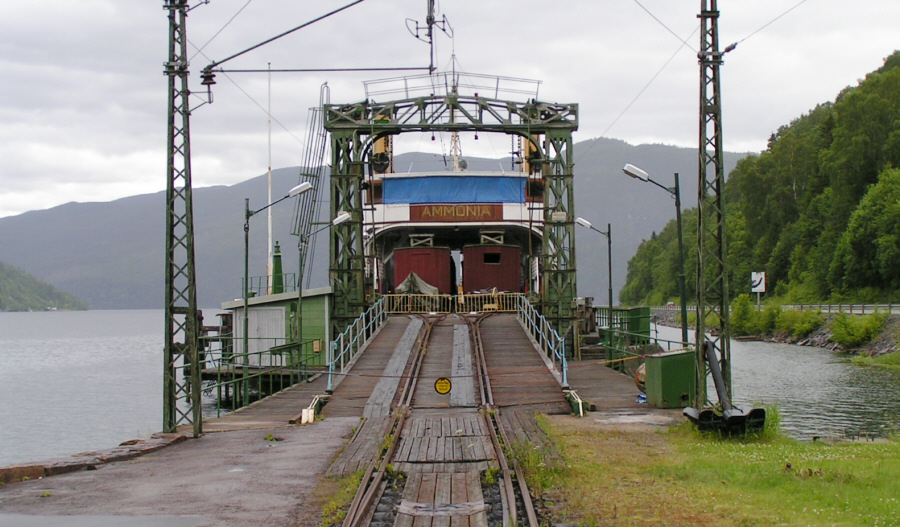- Tinnsjø railway ferry
Infobox Ferry route
name = Tinnsjø railway ferry
nativename =
logosize =
imagesize =
caption = SF "Ammonia", the world's only remaining steam-powered railway ferry, docked at Mæl
crosses =Tinnsjø
route =
line =
carries =Train s
locale =Telemark ,Norway
quays =Mæl Station Tinnoset Station
operator =Norsk Transport
authority =
ferries = SF "Rjukanfoss"
SF "Hydro"
SF "Ammonia"
M/F "Storegut"
ferrytype = Railway ferry
traveltime =
headway =
frequency =
length = convert|30|km|mi|sing=on
opened = 8 December 1911
closed = 5 July 1991
closes =
precessor =
successor =
connection1 = Mæl
train1 =Rjukanbanen
tram1 =
bus1 =Tinn Billag (1971–85)
ship1 =
road1 =
airport1 =
connection2 = Tinnoset
train2 =Tinnosbanen
tram2 =
bus2 =
ship2 =
road2 =
airport2 =Tinnsjø railway ferry was a Norwegian
railway ferry service on the lakeTinnsjø that connected the railways ofRjukanbanen andTinnosbanen . The convert|30|km|mi long ferry trip made it possible forNorsk Hydro to transport itsfertilizer from the plant atRjukan to theport inSkien . The ferry services operated were operated by the companies subsidiaryNorsk Transport from 1909 to 1991, when the plant closed.One of the ferries was in 1944 the target of the
Norwegian heavy water sabotage when it was sunk to 430 meters depth to preventNazi Germany from developingnuclear weapons . [cite web |url=http://www.rjukan-turistkontor.no/uk/attraksjoner/rjukanbanen.asp |title=Rjukanbanen |author=Rjukan Tourist Office |language=Norwegian |accessdate=2006-12-12]History
Norsk Hydro was founded in 1905 by
Sam Eyde as a Norwegian fertilizer manufacturer, and the first factory was opened in Notodden. Fertilizer factories need a lot of energy, making it was necessary to locate the plants near hydroelectric power plants, and at Rjukan there was a large waterfall. In 1911 Rjukan Salpeterfabrikk was opened. [cite web|url=http://www.hydro.com/en/about/history/1900_1917/1906.html |title=The next gigantic step |author=Norsk Hydro |accessdate=2006-12-12]The Tinnsjø railway ferry service was opened in 1909 along with Tinnosbanen and Rjukanbanen. The two lines were the second railway line in Norway, after
Thamshavnbanen , to be electrified in 1911. The railway service used Telemark Canal until 1919 whenBratsbergbanen opened from Notodden to Skien. The railway was used both to transport raw materials to the factory and to transport the finished fertilizer to the harbour at Skien. There was also passenger trains that ran.In 1929 Norsk Hydro also establish itself at
Herøya inPorsgrunn , and in 1991 the factory in Rjukan, and therefore also the railway line, was closed. The passenger trains, operated byNorges Statsbaner , had been discontinued already in 1970. In 1997 the ownership of the track was transferred to Stiftelsen Rjukanbanen, a foundation that started heritage operation of the line in 1999.Ferries
The railway ferry service was provided by four different ships, SF "Rjukanfoss", SF "Hydro", SF "Ammonia" and MF "Storegut". The three first were
steam ship s, and the latter two are still docked at Mæl. The service was the only ever railway ferry service on alake in Norway, and D/F "Ammonia" is the only remaining railway ferry steam ship in the world.cite web |url=http://home.c2i.net/maana/maana/fakta.htm |title=Fakta om Rjukanbanen |author=Maana Forlag |language=Norwegian |accessdate=2006-12-12]F "Rjukanfoss"
SF "Rjukanfoss", built in 1909, was the first railway ferry on Tinnsjø. The
steam ship was 42.2 m (138.3 ft) long and 9.8 m (32.3 ft) wide and 338 gross tonnes. It operated up to two daily departures each way, with a capacity of 120 passengers. The ship was rebuilt in 1946 to 648 gross tonnes but taken out of services and destroyed in 1969.cite web |url=http://home.online.no/~hnisi/tinnoset.htm |title=Tinnoset |author=Helge Nisi |accessdate=2006-12-13 |language=Norwegian ]F "Hydro"
SF "Hydro" was the next ship to operate as railway ferry, entering service in 1914. It was slightly larger than "Rjukanfoss", with 439 gross tonnes, 53 m (174 ft) long and with two 186 kW (250 hp) engines. On
February 20 1944 the ship was blown up by theNorwegian resistance movement at Tinnsjø's deepest point, 430 meters with a load ofheavy water onboard heading forGermany . It is believed that 18 people were killed while 29 survived thesabotage .F "Ammonia"
In 1929 Norsk Hydro expanded their plant, and there was need for a third ferry. SF "Ammonia" was built the same year and was the largest of the three steam ships with 929 gross tonnes, two 336 kW (450 hp) engines and a length of 70.4 m (230.6 ft). It had a capacity of 250 passengers. From 1957 it was made a reserve ferry when "Storegut" was for service. It was taken out of service in 1991 when the railway closed, but can still be seen docked at Mæl. It is the only remaining steam powered railway ferry in the world.
MF "Storegut"
MF "Storegut" is the last ferry and the only
motor ship to operate on the lake. Built in 1956, it weighs 1119 gross tonnes, is 82.7 m (271.4 ft) long with three 1678 kW (2250 hp) diesel engines. The passenger traffic with the ship terminated in 1985, and it was taken out of service in 1991 and is docked at Mæl.References
External links
* [http://www.rjukanbanen.no Stiftelsen Rjukanbanen] Dead link|date=June 2008
* [http://home.c2i.net/maana Web site on Rjukanbanen] no icon
* [http://home.online.no/~hnisi/tinnoset.htm Private web site with focus on ferries on Tinnsjø] no icon
Wikimedia Foundation. 2010.
